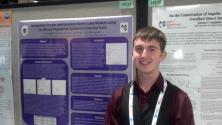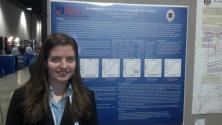American Astronomical Society Meeting
January 6, 2013 to January 10, 2013
Long Beach, CA
Meeting host: By:Rachel Salmon & Chris Culver
SPS Chapter:
In January, we traveled with our research advisor to the 221st meeting of the American Astronomical Society (AAS) to attend talks and present our research in a poster session. We had been working on these research projects for several months and were excited for the opportunity to present our research at the largest annual meeting of astronomers and astrophysicists. We represent the Society of Physics Students chapter at the University of Scranton, located in northeastern Pennsylvania. We attended the meeting to gain experience presenting research in a professional setting. Rachel is a sophomore physics major looking to eventually pursue a doctorate in astronomy or astrophysics, and Chris is a senior physics major headed for graduate school in the fall of 2013. We both work with Dr. Jeremy Sepinsky, assistant professor of Physics at the University of Scranton.
SPS Reporters Rachel Salmon and Chris Culver with their posters at AAS. Photos courtesy of Rachel Salmon. Every six months, the American Astronomical Society holds a conference for the astronomy and astrophysics community to get together and discuss the research they are doing. This meeting was themed around planet‐based research, especially observational based research. The conference is structured so that there are four one‐hour plenary talks each day, with longer sessions of five or fifteen minute talks in between. There are also poster sessions, and we presented the following posters in one of these sessions:
Roche Lobes and the Evolution of Hot Jupiters
By Rachel Salmon
Hot jupiters are characterized by an inflated atmosphere as a result of their close proximity to their parent star. Because of their gaseous atmosphere and small semi‐major axes, it is possible that these systems may undergo Roche lobe overflow at some point during their evolution. Using the updated Roche lobe calculations from Sepinsky et al. (2010) which incorporate the planet’s rotation rate and eccentricity, we calculated the filling fraction of all of the planets in the exoplanet database (exoplanet.eu) as of July 11, 2012. The filling fraction combines semimajor axis, stellar mass, planetary mass, eccentricity, and rotation rate to determine how close a planet is to filling its Roche lobe. After calculating the filling fraction, we selected the 5 planets with the greatest filling fraction that fit the general parameters of a hot Jupiter. We also took the 5 systems with the greatest eccentricity because high eccentricity is an indicator of the possibility for Roche lobe overflow at periastron. We then isolated and manipulated each parameter of the likely systems to determine what adjustments would have to take place in order for the system to have undergone Roche lobe overflow at some point during its evolution. The study of these planets and their evolution will give us a better perspective on the creation and evolution of planetary systems.
Comparing Circular and Eccentric Roche Lobe Models using the Binary Population Synthesis Code StarTrack
By Christopher Culver
It is commonly assumed that eccentric roche lobe overflow happens instantaneously and therefore not over an appreciable timescale when compared with other evolutionary effects. Sepinsky et al. (2007) developed a more complete mathematical model for the roche lobe in eccentric systems and the roche lobe overflow process. Here we include these changes in the population synthesis code Star Track to examine the long term effects on various types of systems. We first examine the timescale for eccentric roche lobe overflow as compared to the other important evolutionary timescales. We then compare the evolution of systems using the eccentric roche lobe overflow calculations to the commonly adopted ones.
Going to a conference like this is a very valuable experience for anyone, from those with PhDs to undergraduates only considering a career in the field. The meeting features the most current research in every subdivision of astronomy, gives you a chance to network with people in your field, and allows you to gain knowledge about astronomy and astrophysics that you might not otherwise encounter.
Not only are there chances for networking and gaining information about current research, there are also countless opportunities to take the information from the conference and bring it home to share with others. One of the highlights of the conference was the opportunity to talk to groups that specialize in astronomy education. We were able to see new ideas for making complex concepts in astronomy accessible to people unfamiliar with the intricacies of the field. In order for the fields of astronomy and astrophysics to thrive, it is necessary to reach beyond the sphere of experts in the field. It is also important to inspire the next generation of astronomers and astrophysicists.
At the AAS meeting, a local group of young students had the opportunity to attend the meeting for a day, touring the posters and interacting with the exhibitors. After the students left, many people took advantage of the opportunity to take part in the activities that were set up for the students. They built pulsars from model magic and LEDs, modeled the universe with marbles and jelly beans, and learned about the fabric of space‐time. This gave attendees a chance to get in touch with their inner child while also learning ways to communicate their research to people outside the field.
We were part of a record number of undergraduate students that attended the AAS meeting. Many undergraduates presented posters during the poster sessions, and it was great to have the opportunity to see the research that other students are doing. To bring the undergraduates together, the Society of Physics Students sponsored a talk one evening specifically for undergraduates. The talk was given by Michael Brown, the self‐proclaimed “killer of Pluto,” and was one of the highlights of the conference. After the talk students were able to share their posters with other undergraduates.
Our attendance at the AAS meeting would not have been possible without the assistance of the Society of Physics Students and our university. Not only did the Society of Physics Students help us get to the meeting, but they also enriched our meeting experience by bringing undergraduate students together allowing us to share our research and common love of astronomy and astrophysics.
Areas of Alignment: Career Resources: Scientific Categories:

